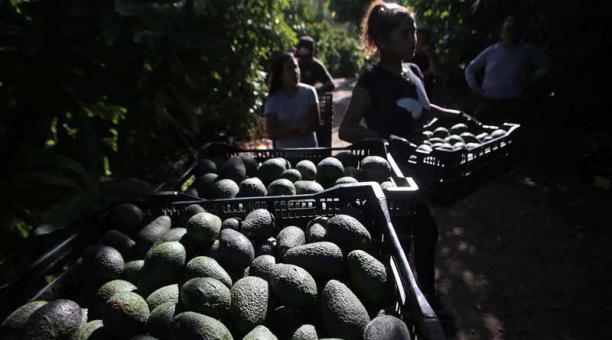The rage of the avocado, the 'green gold' of Latin America
The insatiable demand for this fruit, rich in vegetable fats and also called avocado, meets with criticism because of the environmental impact caused by exploitation in Latin American producing countries such as Mexico, Chile, Peru, or Colombia.

A striking green color that triumphs in social networks and a delicious pulp of innumerable nutritional properties have made avocado a gastronomic star in the United States and Europe. But the voracious demand for this fruit rich in vegetable fats, also called avocado, accumulates detractors for the environmental impact caused by its exploitation in producing countries of Latin America, such as Mexico, Chile, Peru, or Colombia.
The Irish chef JP McMahon, winner of a Michelin star, was one of the first to describe the avocado as a new "blood diamond", announcing that he would stop serving the valued fruit in his restaurants in Galway, on the west coast of the island. Others followed him. "I was shocked by the fact that we do not associate avocado with climate change or deforestation because it is a symbol of health in the Western world," McMahon told AFP. This is the problem in two producing countries of the region.
Mexico produces more avocados than anywhere in the world. Only in the second week of January, a truck left the state of Michoacán every six minutes loaded with fruit, the main ingredient of guacamole that Americans consume massively during the Superbowl, scheduled next Sunday (February 3, 2019). Most of their crops are located in the volcanic soil of this western state of Mexico, one of the most plagued by violence. This has not stopped the export of this berry, especially to the United States, the destination of 80% of its avocados. In the period 2018-2019, 377 411 tonnes have already been sent, 13% more than in the same period before.
To other markets 57 376 tons were exported, 8% more, according to figures from the Association of Producers and Packers Exporters of Avocado of Mexico (Apeam). According to some researchers, the illegal plantings of this "green gold" have generated the deforestation of thousands of hectares of forests in this state of almost 5 million inhabitants. The law in Michoacán only authorizes to change the vocation of the forest floor for agriculture when the trees of certain lands are cut or burned.
"There is a very common practice among forest owners to plant their avocados under the forest trees and then they gradually cut or dry the forest trees to leave the avocados exposed," explained Luis Mario Tapia Vargas, a researcher at the National Institute of Forestry, Agricultural and Livestock Research (Inifap).
Another way is through fires. According to Tapia, 95% of the losses in these areas are caused. In dry years, he explains, the burned forest area can reach up to 10,000 hectares. Illegal land, on the other hand, amounted to 15,000 according to this researcher in 2018. "For a fine or a charge (bribe) that is applied, it is allowed to plant new surfaces," he says. The adviser and spokesman of the APEAM, Ramón Paz Vega, assures that some research shows that massive deforestation occurred several years before the production of avocado was expanded, starting in 1997.
"The above does not mean that avocado production has no environmental effects; it has them, "he says. The industry is also an important source of work. According to APEAM, it currently creates more than 75,000 permanent jobs and up to 30,000 indirect jobs. "Without this crop, many of these small farmers and workers would-be migrants, or members of organized crime, or poor peasants," says Vega.
"There are children between 10 and 12 years old who do not know the river," says Rodrigo Mundaca, spokesman and founder of Modatima, a water defense organization, from Petorca province, in central Chile. In this town, 150 km from Santiago, a large part of the export avocados, the so-called Hass Avocado, are produced. In the 2017-2018 season, the country produced about 225,000 tons of avocado, according to the Hass Chili Avocado Committee. 30% was destined to local territory and the remaining 70% was exported mainly to Europe, the United States, China, and Argentina.
The industry faces large producers and residents of Petorca due to the severe droughts suffered by the area. Locals point directly to agricultural production companies, especially avocado, to have generated this problem. Due to its characteristics, the avocado needs an important amount of water to be cultivated, about 100 000 liters per day, according to Mundaca, which leaves about 3,000 inhabitants of Petorca without water "to satisfy their basic needs".
According to his estimates, avocado crops currently extend for some 9,000 hectares and 60% of the area is established in areas that are not properly cultivated. In the 1990s, they did not reach 2 000 hectares. According to the organization, "improper practices" are carried out, consisting of draining rivers and building engineering works to capture groundwater.
What they appeal to is the ethical conscience of consumers. Logic similar to the one that chef McMahon is using in Ireland. "Do we need avocados all year? We have to start thinking about where the food comes from. What is good in one country may not work in another," he says.
This content has been originally published by Diario EL COMERCIO at the following address:
https://www.elcomercio.com/tendencias/preocupacion-furor-aguacate-deforestacion-ambiente.html




